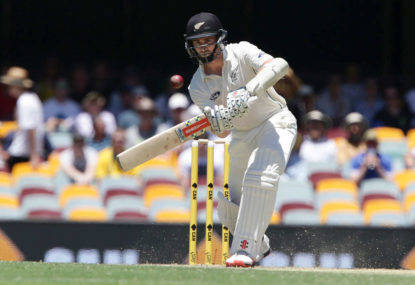Cricket is a sport steeped in tradition. It still uses 19th century terms for breaks in play, and gentlemen watching the sport still dress up in suit and tie, especially at Lord’s, the home of cricket.
Spectators stand and applaud opposition achievements, players are chastised for not congratulating their opponent’s achievements. There is even a lengthy preamble to the official rulebook that heavily refers to the ‘Spirit of the Game’. Yes, capitals are used.
So how does a sport steeped in so much history and tradition progress and thrive in the 21st century?
Let’s start by saying these customs are not necessarily a bad thing. They definitely draw in a lot of fans and are appealing qualities for a sport to possess.
Where else do you see players forming a guard of honour during a match for a retiring player? When is the last time you can remember a rugby league player applauding when the opposition scored a try? The vitriol directed towards Adam Goodes over the past two years would never be accepted at Lord’s.
But it’s also very important for a sport to not get stuck in the past. To be left behind by more modern, innovative and entertaining sports. This is the battle cricket is currently wrestling.
On Friday afternoon the sport will enter a new era. The first ever day-night Test match will be played. A sport played between the hours of 11am and 6pm for years. A sport in which play is normally stopped due to bad light is now being played at night. For certain fans the sanctity of cricket will be lost forever when the players step foot onto the Adelaide Oval at 2:30pm on Friday afternoon.
To some it is absolutely vital that cricket maintains as many traditions and customs as possible. Some don’t even recognise One-Day or Twenty20 cricket as ‘real’ cricket. It’s Test cricket or nothing for them.
That’s all well and good but the fact is Test cricket is declining in popularity around the world. Ashes cricket remains as popular as ever, although that may change if Australia and England keep playing each other almost every summer. And Australia’s clashes with India are highly attended clashes. Other than this however, Test matches around the world are suffering from diminishing crowds. Even in India crowds are dropping for Test matches while the shorter forms of the game soar in popularity.
Last week’s Test in Perth between Australia and New Zealand was attended by just over 13,000 fans on the first day, with 3000 fans attending the fifth and final day in a Test that was still in the balance. Yes, it’s November and November Tests are always poorly attended, but November Tests aren’t going anywhere. In October, 54 people attended a day of cricket between England and Pakistan in Abu Dhabi. Yes, you read that right, 54 people. The matches I played as an 11-year-old generated bigger crowds.
There can no longer be any denying that the ICC has to do something to ensure the long-term popularity of Test cricket. Unfortunately some of these measures may alter the traditions that have been followed for more than 200 years.
But we have been breaking traditions for years now. Timeless Tests were stopped 76 years ago, and cricket was first played at night almost 40 years ago. Concepts that were once considered blasphemy are now considered regular parts of the sport.
If day-night Tests become common place in a highly popular and rejuvenated Test cricketing world, in 50 years time we will be looking back on this day as a turning point in the sport. That is why this is worth a try. Because years of research and thought has been put into its implementation, because the benefits have been weighed up against the costs and because the benefits far outweigh these costs.
Yes, there are concerns about the ball and yes, there will likely be some hiccups in this historic Test. But that’s life. Not everything always goes to plan and it’s a concept worth persisting with, just like World Series Cricket was when less than 2000 people turned up to the first ever game at VFL Park.
That’s not to say all measures to improve the game should be adopted. Some of them will alter the fabric of the game far too much.
Reducing Tests from five days to four is one such example. There are just so many variables at play. In a perfect world all stars will align and four-day Tests will be a success, but the world is not perfect. There are just too many variables that will influence the success of four-day Tests. Additionally the impacts of such a move are too wide-ranging.
The risks of a day-night Teat are relatively low, should the ball hold up it will likely be a success. The risks associated with four-day Tests are far greater. We don’t know that captains will suddenly become more attacking because Tests are a day shorter. We may lose the art of spin in non-subcontinent countries if pitches aren’t adjusted accordingly. Thus at the moment anyway, four-day Tests are just a bridge too far in terms of altering the sport.
In proposing and implementing these many changes the ICC and cricketing organisations around the world are addressing the symptoms without actually addressing the root cause of the problem.
Why do a lot of people ignore Test cricket? Because it can get boring, dull and predictable and matches can just drag on. We then need to be asking why this happens. The answer is that Test cricket is not competitive.
In the past decade we have seen Bangladesh fall from easy beats to almost non-existent. We have seen Zimbabwe drop even further from an even lower base. We have seen the West Indies spiral out of control, to the point now that they are seen as an international embarrassment.
We have seen Sri Lanka struggle mightily, and these struggles are expected to continue with a host of ageing legends retiring recently. There are grave fears for South Africa’s future once their ageing stars retire. New Zealand and Pakistan are the only bright spots in terms of play, but even then, Pakistan hasn’t played at home since 2009.
The triumvirate of Australia, England and India are effectively creating a two-tier international system and it has to stop. The ICC must to do everything it can to ensure that every Test match is competitive and played by two relatively evenly matched teams who have a chance to win.
Cutting Tests by a day doesn’t do this; it just shortens the pain for the weaker teams. Instead money has to be invested in order to develop the sport in existing and growing nations. Something has to be done to ensure the most talented Caribbean teenagers become fast bowlers and not international sprinters.
Cricket needs to evolve in order to remain popular in a competitive global sporting marketplace. The most effective method of remaining popular is to ensure the product on the field is the best possible product.
Day-night Test cricket will guarantee easy access to this product, but the ICC must do the hard work behind the scenes in order to ensure the fans want to watch what is being delivered. Because at the moment, unless Australia, India or England are playing each other, fans don’t want to watch it.





































































































